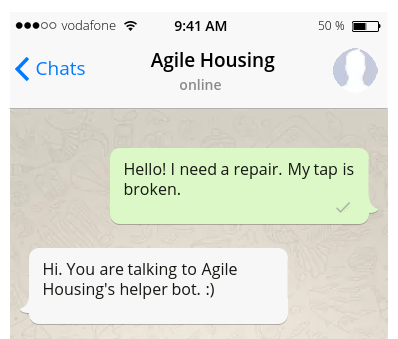This morning I was thinking about what interaction with services might look like in the future. At the moment we’re concentrating on digital services in terms of the web but there’s a trend emerging for zero user interface — sometimes referred to invisible apps.
The popularity of text messaging apps (Whatsapp, Messenger and most recently Telegram) means that people are often able to communicate more rapidly via text than go scouring the web for information or download a specific app for a specific organisation. Essentially what we’re talking about is doing away with extra web portals and bespoke apps and offering services via the channels that people already use and know their way around.
Last year, Facebook announced plans for ‘Business on Messenger’. Essentially this allows users of Messenger to chat directly with a business during checkout, receive updates on an order and ask free-form questions. The goal being a direct and instant communication between customer and business to improve the shopping experience.
Slack, the wildly popular messaging platform, has been leading the charge for text automation with Bots. These are computer controlled users that can carry out automatic processes or remember stuff. The example below shows a Bot which is able to keep a centralised grocery list. But people have begun using them for managing more complex (but logical) processes like dealing with expenses.

So, what if we had a centralised Bot connected to all our services in Housing? What might that look like? I mocked up a repairs conversation below to better visualise it.


This is a very simplistic example. Based on the difficulty of repair, the Bot could talk the resident through fixing it themselves. The Bot could also request a photo of the problem to attach to the repair job so that the operative knows what they’re dealing with before they arrive at the property.
We are already starting to see the use of deep learning to analyse photos to detect what’s in them. Google is using this to great effect in its photo service to sort images by content (pictures of the beach, pictures of boats, pictures of me etc.). Not hard to think of a future where the Bot could detect the type of repair merely by analysing what’s in the photo.
The real beauty of this is that the bot could communicate through multiple mediums (SMS, Email, Chat or even good old fashioned paper in the post) and even converse in different languages on the fly based on the preferences of the resident.
Aside from dealing with external service requests, there’s no reason why it couldn’t also assist staff inside the organisation too. Think of all the routine office tasks that require cognitive load we could outsource to our Bot helper…
- Meeting requests
- Availability
- Scheduling 1 to 1’s
- Invoicing
- Expenses
- Reporting
- Clocking In / Out
- Holidays
Obviously —there’s a bucket load of caveats here around available API’s to hook the Bot into all those back office systems (cue my rant about using open source / open standards) but looking at the work currently being done in Slack, this doesn’t seem like its outside the realms of possibility.
